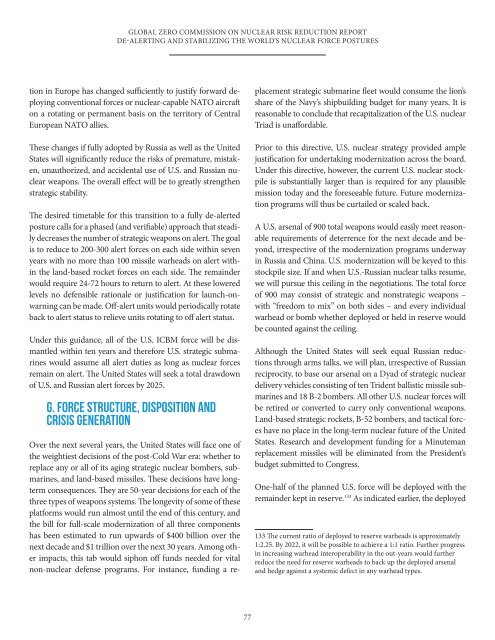global_zero_commission_on_nuclear_risk_reduction_report
global_zero_commission_on_nuclear_risk_reduction_report
global_zero_commission_on_nuclear_risk_reduction_report
Create successful ePaper yourself
Turn your PDF publications into a flip-book with our unique Google optimized e-Paper software.
GLOBAL ZERO COMMISSION ON NUCLEAR RISK REDUCTION REPORTDE-ALERTING AND STABILIZING THE WORLD’S NUCLEAR FORCE POSTURESti<strong>on</strong> in Europe has changed sufficiently to justify forward deployingc<strong>on</strong>venti<strong>on</strong>al forces or <strong>nuclear</strong>-capable NATO aircraft<strong>on</strong> a rotating or permanent basis <strong>on</strong> the territory of CentralEuropean NATO allies.These changes if fully adopted by Russia as well as the UnitedStates will significantly reduce the <strong>risk</strong>s of premature, mistaken,unauthorized, and accidental use of U.S. and Russian <strong>nuclear</strong>weap<strong>on</strong>s. The overall effect will be to greatly strengthenstrategic stability.The desired timetable for this transiti<strong>on</strong> to a fully de-alertedposture calls for a phased (and verifiable) approach that steadilydecreases the number of strategic weap<strong>on</strong>s <strong>on</strong> alert. The goalis to reduce to 200-300 alert forces <strong>on</strong> each side within sevenyears with no more than 100 missile warheads <strong>on</strong> alert withinthe land-based rocket forces <strong>on</strong> each side. The remainderwould require 24-72 hours to return to alert. At these loweredlevels no defensible rati<strong>on</strong>ale or justificati<strong>on</strong> for launch-<strong>on</strong>warningcan be made. Off-alert units would periodically rotateback to alert status to relieve units rotating to off alert status.Under this guidance, all of the U.S. ICBM force will be dismantledwithin ten years and therefore U.S. strategic submarineswould assume all alert duties as l<strong>on</strong>g as <strong>nuclear</strong> forcesremain <strong>on</strong> alert. The United States will seek a total drawdownof U.S. and Russian alert forces by 2025.G. FORCE STRUCTURE, DISPOSITION ANDCRISIS GENERATIONOver the next several years, the United States will face <strong>on</strong>e ofthe weightiest decisi<strong>on</strong>s of the post-Cold War era: whether toreplace any or all of its aging strategic <strong>nuclear</strong> bombers, submarines,and land-based missiles. These decisi<strong>on</strong>s have l<strong>on</strong>gtermc<strong>on</strong>sequences. They are 50-year decisi<strong>on</strong>s for each of thethree types of weap<strong>on</strong>s systems. The l<strong>on</strong>gevity of some of theseplatforms would run almost until the end of this century, andthe bill for full-scale modernizati<strong>on</strong> of all three comp<strong>on</strong>entshas been estimated to run upwards of $400 billi<strong>on</strong> over thenext decade and $1 trilli<strong>on</strong> over the next 30 years. Am<strong>on</strong>g otherimpacts, this tab would siph<strong>on</strong> off funds needed for vitaln<strong>on</strong>-<strong>nuclear</strong> defense programs. For instance, funding a replacementstrategic submarine fleet would c<strong>on</strong>sume the li<strong>on</strong>’sshare of the Navy’s shipbuilding budget for many years. It isreas<strong>on</strong>able to c<strong>on</strong>clude that recapitalizati<strong>on</strong> of the U.S. <strong>nuclear</strong>Triad is unaffordable.Prior to this directive, U.S. <strong>nuclear</strong> strategy provided amplejustificati<strong>on</strong> for undertaking modernizati<strong>on</strong> across the board.Under this directive, however, the current U.S. <strong>nuclear</strong> stockpileis substantially larger than is required for any plausiblemissi<strong>on</strong> today and the foreseeable future. Future modernizati<strong>on</strong>programs will thus be curtailed or scaled back.A U.S. arsenal of 900 total weap<strong>on</strong>s would easily meet reas<strong>on</strong>ablerequirements of deterrence for the next decade and bey<strong>on</strong>d,irrespective of the modernizati<strong>on</strong> programs underwayin Russia and China. U.S. modernizati<strong>on</strong> will be keyed to thisstockpile size. If and when U.S.-Russian <strong>nuclear</strong> talks resume,we will pursue this ceiling in the negotiati<strong>on</strong>s. The total forceof 900 may c<strong>on</strong>sist of strategic and n<strong>on</strong>strategic weap<strong>on</strong>s –with “freedom to mix” <strong>on</strong> both sides – and every individualwarhead or bomb whether deployed or held in reserve wouldbe counted against the ceiling.Although the United States will seek equal Russian reducti<strong>on</strong>sthrough arms talks, we will plan, irrespective of Russianreciprocity, to base our arsenal <strong>on</strong> a Dyad of strategic <strong>nuclear</strong>delivery vehicles c<strong>on</strong>sisting of ten Trident ballistic missile submarinesand 18 B-2 bombers. All other U.S. <strong>nuclear</strong> forces willbe retired or c<strong>on</strong>verted to carry <strong>on</strong>ly c<strong>on</strong>venti<strong>on</strong>al weap<strong>on</strong>s.Land-based strategic rockets, B-52 bombers, and tactical forceshave no place in the l<strong>on</strong>g-term <strong>nuclear</strong> future of the UnitedStates. Research and development funding for a Minutemanreplacement missiles will be eliminated from the President’sbudget submitted to C<strong>on</strong>gress.One-half of the planned U.S. force will be deployed with theremainder kept in reserve. 133 As indicated earlier, the deployed133 The current ratio of deployed to reserve warheads is approximately1:2.25. By 2022, it will be possible to achieve a 1:1 ratio. Further progressin increasing warhead interoperability in the out-years would furtherreduce the need for reserve warheads to back up the deployed arsenaland hedge against a systemic defect in any warhead types.77


